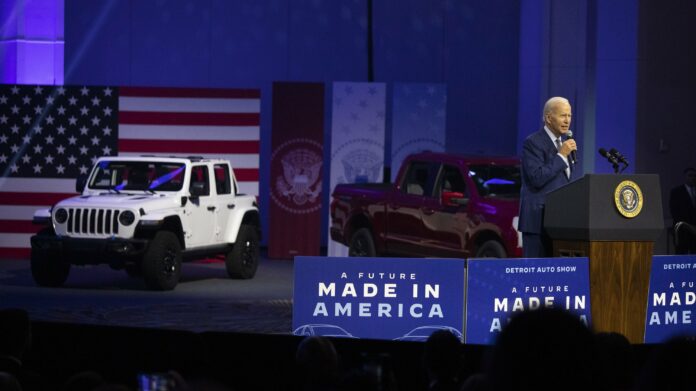President Biden today announced $2.8 billion in grants to support domestic battery manufacturing as part of his administration’s goal to have electric vehicles make up half of all new vehicles sold in the US by 2030.
The funding will support two facets of battery production:
-
Mining and processing “critical minerals” like lithium and graphite under the new American Battery Materials Initiative.
-
Battery manufacturing and assembly
The move comes amid pushback from foreign(Opens in a new window) and domestic automakers over the requirements to have their EVs qualify for a $7,500 tax credit put in place as part of the Inflation Reduction Act.
For vehicles to qualify, the automaker must assemble the car and battery in the US, as well as mine a certain percentage of the minerals inside the battery domestically. These are big hurdles given the nascent battery and minerals industry in the US, leaving some companies scrambling to qualify their vehicles(Opens in a new window) to stimulate sales.
“China currently controls much of the critical mineral supply chain and the lack of mining, processing, and recycling capacity in the US could hinder electric vehicle development and adoption, leaving the US dependent on unreliable foreign supply chains,” the White House says(Opens in a new window).
Lithium mine in Australia, one of the world’s largest lithium producers after China.
(Credit: Bloomberg/Getty Images)
Bolstering US production aims to “improve America’s energy independence, strengthen national security, support good-paying jobs across battery supply chains, and lower costs for working families,” the White House adds.
Hopefully, it also means a greater chance your next EV purchase will qualify for the credit, but it will take a few years to construct new facilities. By the numbers, the funding will be enough for:
-
Twenty manufacturing and processing companies in 12 states, including Alabama, Georgia, Kentucky, Louisiana, Missouri, Nevada, New York, North Carolina, North Dakota, Ohio, Tennessee, and Washington.
-
Enough battery-grade lithium for 2 million EVs annually, as well as graphite and nickel production.
-
A few firsts: the first commercial lithium electrolyte sale production facility, the first lithium iron phosphate cathode facility, and the first commercial scale domestic silicon oxide production facilities.
-
45% of the domestic need for battery binders(Opens in a new window).
The planned Thacker Pass lithium mine is the largest known lithium deposit in the US, and has drawn concerns and protests from environmental groups, Native American tribes, and local ranchers.
(Credit: Xinhua News Agency/Getty Images)
To combat the not-so-glamorous side of mining all these minerals, the bill promises “a faster and fairer domestic process that meets strong environmental and labor standards, ensures meaningful community engagement and consultation with Tribal Nations, and reduces time and cost of permitting.”
A new “battery belt” has emerged since the Biden administration announced the federal tax credit over the summer, with multiple automakers committing to domestic battery production.
Recommended by Our Editors
Today, for example, BMW announced(Opens in a new window) a $1.7 billion investment that includes $1 billion to prepare for the production of EVs at its existing US manufacturing facility in Spartanburg, South Carolina, and $700 million to build a new high-voltage battery assembly facility in nearby Woodruff, SC.
Last week, Honda also confirmed(Opens in a new window) it will build a $4.4 billion battery factory in Fayette County, Ohio, in partnership with LG Energy Solution. Ford(Opens in a new window), GM, Volkswagen(Opens in a new window), and Stellantis (Jeep, Dodge, Chrysler) have similar plans.
Vehicle batteries on the production line at the VinFast factory in Haiphong, Vietnam.
(Credit: Bloomberg/Getty Images)
The “rust belt,” a term for the factory-rich region of the US that has seen many of those facilities close as the work moved overseas, is also getting a revival with EV production (Biden said recently(Opens in a new window) it should be renamed the “Silicon Heartland”). General Motors(Opens in a new window), Tesla, Rivian, and others will produce EVs in the US in order to qualify their vehicles for the credit.
Get Our Best Stories!
Sign up for What’s New Now to get our top stories delivered to your inbox every morning.
This newsletter may contain advertising, deals, or affiliate links. Subscribing to a newsletter indicates your consent to our Terms of Use and Privacy Policy. You may unsubscribe from the newsletters at any time.
Hits: 0


















